Forum Replies Created
-
AuthorPosts
-
 Bill WardParticipant
Bill WardParticipantHi,
Things just got interesting again…!
One of the other NEMETODE observers, Allen Carter, now runs a system identical to mine (A Watec 910/12mm f0.8/600g/mm) and managed to catch a couple of spectra from the peak of the Quadrantids. Allen kindly sent me his images to analyse and the results are great.
Last year seemed to indicate a very distinctive spectrum for the QUA meteoroids. My spectra were quite conclusive on the composition but being a single station there was the possiblity of mis-identifying a weaker Dec Alpha Draconid stream as a QUA.
There seems little doubt now that the QUA’s are “sodium deficient” cf magnesium. What this means has to do with the parent body and it’s possible origin and orbit. That’s now a whole new story to be explored…
Here is one of my spectra from last year.
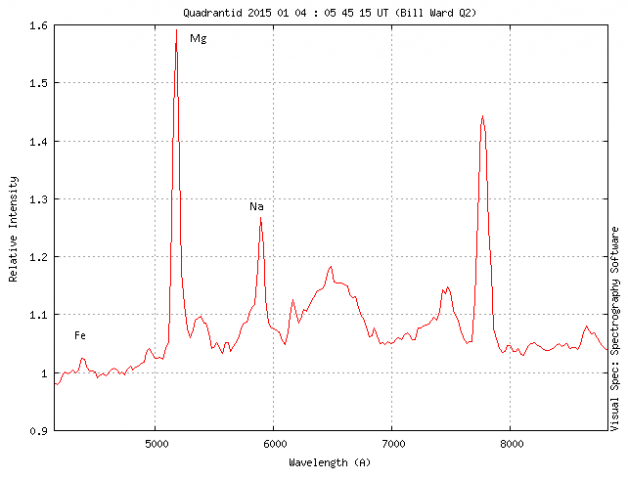
and here is Allens from this year (basically yesterday, at date of posting!)
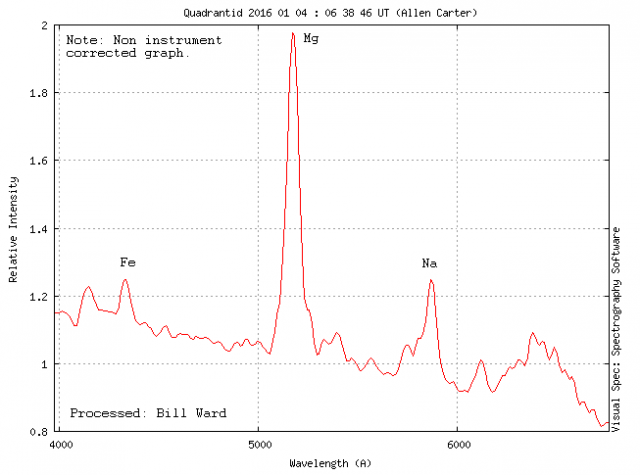
I’ve added the main lines for comparison. Mine caught a little more in the near IR so has a longer wavelength span but it is clear the blue/green regions are almost identical. Importantly both having a large Mg peak.
There may be wavelength resolution limits which has some impact on line ID with video work but I think this is an excellent example of the utility now to be had from meteor spectroscopy on conducting comparative analysis (just like my STA examples). The key issue is that unlike imaging, spectroscopic observations can be directly compared station to station essentially without ambiguity.
RESULT!
Thanks to Allen Carter (and other Nemetode stations) for his support in providing his observations to me.
Now all we need are some spectra of the Dec Alpha Draconids to be able to compare stream to stream!
cheers,
Bill.
 Bill WardParticipant
Bill WardParticipantHi,
Thanks for the paper info. It’s an interesting read. Jenniskens makes reference to the same object in his book Meteor Showers and their parent bodies. He ends the section on the Quadrantids with the same sentiment, that it’s not quite a done deal yet.
Yes, I’m very pleased that after a little evangelising 😉 others have joined in the new pursuit of “Survey Video Meteor Spectroscopy”. It’s taken me 7 years to refine the system but I think its now gone from novelty to utility and that’s great. It is indeed a powerful tool and who knows what it will turn up in the coming years. The regular showers are interesting enough BUT its the sporadic population where I believe the real surprises will be.
I think I mentioned “family groups” elsewhere and I’m pretty sure I’ve started to see this. Initally three spectra caught my eye. These were all from different observers over several years. That has now gone up to six sporadics with very similar properties so theres something going on!
cheers,
Bill.
 Bill WardParticipant
Bill WardParticipantHi Nick,
Sounds great.
Other obsevers not that many miles away also had good conditions, very frustrating!
ALL weather is local as they say… 😉
cheers,
Bill.
 Bill WardParticipant
Bill WardParticipantI’ve only ever seen an handful of flashes that might have been “point meteors” and the only picture of definite ones I’ve seen is the famous one from the Leonids in 1966.
Slightly elongated so maybe it was only VERY close to the radiant 😉
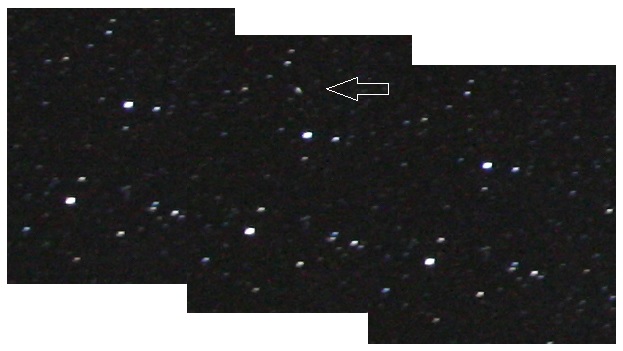
The image shows crops from the all sky camera with one image before and after. Meteor is indicated.
cheers,
Bill.
 Bill WardParticipant
Bill WardParticipantDavid,
The curve is generated very crudely with the “slice” function in iris. This is then saved as a text file with the relative intensities.
It is then dropped into either excel for a quick look, like this, or GNUplot for a more upmarket finish.
Grant,
Yes, the devices are interlaced. this is what generates the spikey appearence as the meteor moves.
And, no there is no dark subtraction. At video rates the noise level is already quite low so I’ve never bothered with it. The real problem is good flat fielding. That’s a different challenge!
cheers,
Bill.
 Bill WardParticipant
Bill WardParticipantHi Grant,
Perhaps not….
Whilst I haven’t “set” any parameters it might not necessarily mean that something I don’t know about may be going on. It’ll be interesting to double check just in case (As or when I ever get to see the sky again. Apart from some very short windows all it has done here is rain for week after week. Very depressing) 🙁
However as a more quantative look at the fade here is a light curve I made of the first one I reported. The rapid onset is quite typical but the slower decay is clearly seen. As commented, this particular meteor is also one of the multi brightness peak class that occur.
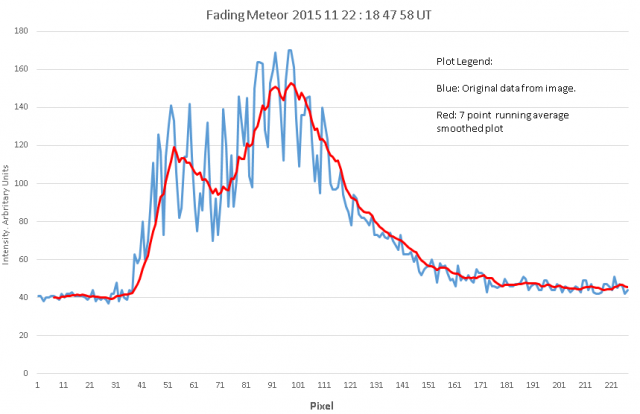
cheers,
Bill.
 Bill WardParticipant
Bill WardParticipantHi,
The 910 can do all sorts of onboard processing and summing but I just run them at the standard single exposure video rate.
Cheers,
Bill.
 Bill WardParticipant
Bill WardParticipant Bill WardParticipant
Bill WardParticipantHi,
This particular spectrum continues to reveal remarkable subtleties…
From the two graphs of the flare and fragment the sodium lines looks very broad in the flare but doing another comparision with the synthetics I think this gives a really good impression of it’s “fuzziness” (thats a technical spectroscopy term 😉 )
However some of the lines in the flare spectrum seem to be a little sharper than the equivalent lines in the fragment. That is the other way round. I’m pretty sure this is some thermal broadening effect of the spectrum and is related to the particular atomic properties of the individual elements involved.
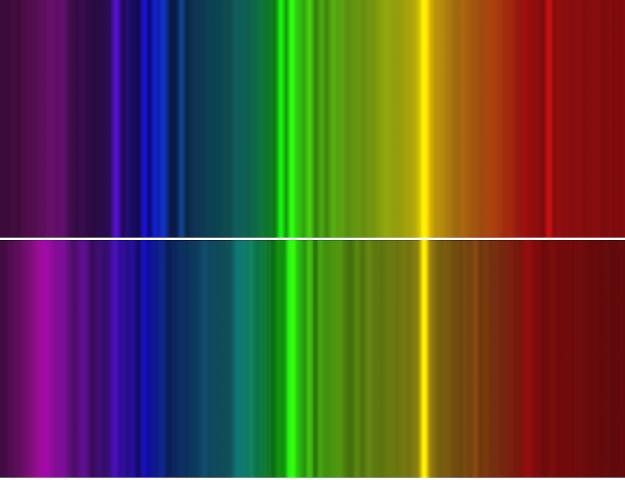
As mentioned in the previous posts’ the ubiquitous Jiri Borovicka wrote some research papers about “dual temperture” emissions. I’ve read this stuff several times and I’m still not completely clear on it. His 1993 (not ’94 as I said) paper on a fireball spectrum is pretty heavy duty. This involves looking at multiplet lines and their respective “curves of growth”. These can be used to imply temperatures and seems to come up with this, rather odd situation to me at least, of something being at two temperatures at the same time. But also as previous, the timescale between the maximum light, where I would have thought temps and pressure would be a max is separated from the cooling bit by only a few milliseconds. This looks very much a non equilibrium process. I’m beginning to think it’s more of an “energy” thing rather than temperature in the usual manner.
It’s all good….
cheers,
Bill.
 Bill WardParticipant
Bill WardParticipantHi,
Great catch, that is an immense terminal flare!
cheers,
Bill.
 Bill WardParticipant
Bill WardParticipantAn interesting development that only spectroscopy can reveal an insight into…
(Or possibly throw a red herring!)
I received a tweet from another observer (JS) enquiring as to the possibility of this particular fireball being a Southern Taurid.
Initially I said no because the observations by the NEMETODE members had indicated a sporadic but the elements had some similarities. I remembered that last year around the same time I had caught another fireball that I was confident was a STA but didn’t have any orbital data.
I dug out the image and plotted the spectrum, then overlaid the spectrum of this years “sporadic”. Apart from some minor lines that may or may not be real, the bulk spectrum signatures are essentially identical! I found this to be both an impressive correlation and an intruiging result!
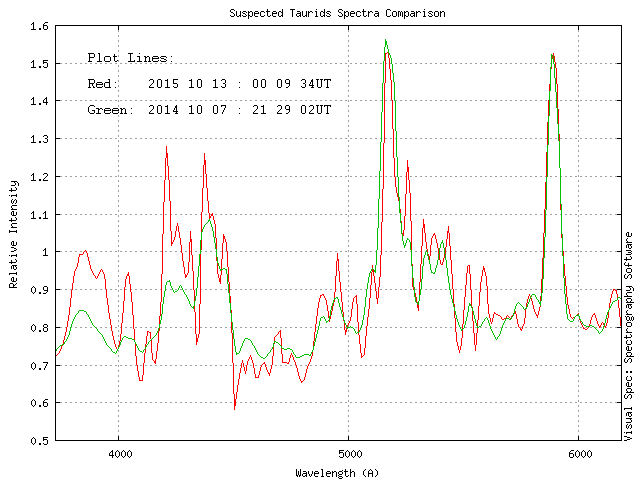
So what is the truth?, difficult to say but in the first instance the evidence point to the two meteoroids being made of the same stuff. JS had caught a still image with the fireball of this year and it certainly tracks back to the general region of the STA radiant despite not matching exactly (by UFO). Perhaps this one is a little bit of Comet Encke that’s been perturbed gravitationally (by Jupiter) or has been ejected with such a velocity that it has evolved into a slightly different orbit.
No matter, through spectroscopy, the evidence of the compositional similarity is very good.
Cheers,
Bill.
 Bill WardParticipant
Bill WardParticipant…and some more number crunching that I’m not very sure about.
If the absolute magnitude and velocity as derived by UFO capture are roughly correct then this yields a mass of around 20g for the meteorid. This is with some of those assumptions I mentioned but it’s the correct “order of magnitude” as they say… 😉
 Bill WardParticipant
Bill WardParticipantHi,
With the power of modern software it is possible to calculate all sorts of things. Thanks to the other observers of the NEMETODE group the orbit of this particular body has been determined. Using a couple of the orbital elements the meteoroids velocity can be calulated not only at the impact point with Earth but also at any point. However it’s interesting to compare the velocity at perihelion, ~64.1km/s and at aphelion, ~ 5.5km/s to the Earths own ~30km/s. From cruising out near Jupiter to whizzing along as it rounded the sun before it’s fateful encounter….
Bill.
 Bill WardParticipant
Bill WardParticipantHi Robin,
Thanks for your thoughts.
What you’ve described is pretty much what it is I think. The issue is with some of the remenant lines in the flare (the cooling section if I understand you) that are not atmospheric.
This isn’t a particulalry good graphic but if you look closely at the strong line at 777.4 nm, immediately to the left of it is another line. This can be seen if you examine the composite closely. (Purple is the flare section, blue is the weaker “gap” sepctrum and red is the fragment.)

This MAY be a triply ionised silicon line. In the only other case that I’ve recorded this type of behaviour, a Perseid fireball in 2013, this and other features were attributed by Jiri Borovicka as being deep blue lines overlapping from the next order. Jiri kindly provided a fully annotated graphic that I included in the Perseid short paper mentioned. Due to the quality of the Persied spectrum I couldn’t really argue (and of course it may very well have been completely different) but in this case I don’t think there is any doubt. Looking at the blue lines they suffer rapid de-focus and the same effect would be seen from the next order up. In this case the line is quite sharp so I believe it is a geniue emission at that wavelength. Also the other peaks in the purple line may be from silicon. Absolute identification is impossible, though due to the low resolution and that is the big problem!
There must be a short interval of time, of the order of a few milliseconds when the crushing pressure on the meteorid is a max and so probably is the temperature. This may momentarliy cause what might be called a “flash boiling” of the surface. The calculations are fraught with so many assupmtions that it’s impossible to say for sure what any given case is though. Clearly there is a fragment that exists for a few more milliseconds so it mast have had some material integrity. So what I think is being seen is emission from the cloud of meteoroid vapour generated at the max P and Max T if the meteoroid is tough enough to survive the whack it gets at this point. However if these lines are indeed silicon from the breakdown of SiO2 (silica/quartz) one of the peaks in the flare spectrum should (perhaps could ?) be O at 615.7nm and be of meteoroidal origin and not atmospheric.
I can’t lay my hands on it as I type but Jiri Borovika also wrote a paper in 1994 about a “twin temperature” model that could be used to explain particular emissions. I think these were in the region of 3000K and 10000K if memory serves. I’m afraid I just don’t know enough about the chemistry/physics/quantum mechanics to fully understand how it actually works. The best I can do is to read it as some “part” of the meteor is at one temp, maybe this is the hotter flash cloud. The another “part”, the surviving fragments, are at the lower temp due to whatever particular bulk thermal properties the meteoroid has.
We need more examples and better resolution!
Cheers,
Bill.
 Bill WardParticipant
Bill WardParticipantHi,
Here’s a spectrum from the image taken just before the brightest flare.
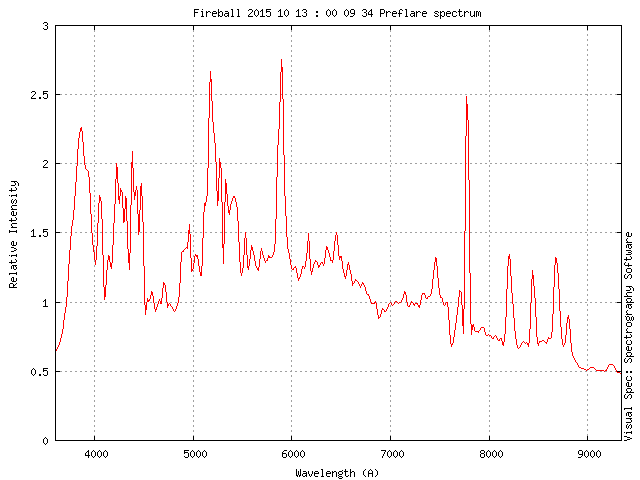
It’s almost the same as the “fragment” spectrum. Perhaps un-surprising, what goes in ends up coming out!. But it begs the question what happens during the flare to stimulate the other emissions. More digging required….
Anyway, it looks very nice…

cheers,
Bill.
 Bill WardParticipant
Bill WardParticipantHi,
Andy, There was a lot of work done by the pros during the Leonid storms. There were several examples of this kind of behaviour caught but on CCD, not on video as far as I know. The experts like Borovicka and Jenniskens have written many scientific papers about this sort of thing. There are a lot of theoretical issues that need to be considered and I don’t fully understand all of it. I just don’t have the experience of “modelling” they do!
Steve, No it’s not a star analyser but still a grating just with more grooves in it. The one used in this case has 600 grooves/mm and is 50mm square (I think the star analyser has 100 or 200 grooves/mm). If you’ve got one and you’re interested in trying meteor spectroscopy then a star analyser can be used but it can only produce low resolution spectra.
cheers,
Bill.
 Bill WardParticipant
Bill WardParticipantHi Andy,
I hope you have a go sometime. The arrangement for meteor spectroscopy couldn’t really be any simpler. I use an empty filter holder of the appropriate size (so the square transmission gratings fits into the circular aperture) secure it with the mounting ring (sometimes a piece of black card and some tape are needed to make up a holder to ensure a secure fit) then screw the the thing onto the lens.
There are some schools of thought about tilting the grating, since we’re using transmission gratings, to optimise performance in a given order. I don’t think its really worth the extra mechanical akwardness. Mind you I’ve yet to see any spectra from a tilted grating system to do a comparison with, so maybe it is…. Achieving good focus across as wide a range of wavelengths as possible is difficult (this is where tilting the grating might make a difference as well) It’s definitely a trade off between utility and absolute performance. Optical aberations, quality of lens design and the way it’s been corrected come into play as well. Is it worth tilting the grating and all that entails to do it only to have the quality dimished by lens limitations? Defocus in the near UV/Blue is rapid and dramatic in most CCTV lenses as they’re not really designed for astronomical spectroscopy! If they were they’d be made of fused silica/quartz and cost a LOT! (however such lenses are available if you REALLY want to get into it….)
Yes, I’ve been looking at ISIS as well. Some of the results Christian gets are simply remarkable. I had a look at his page recently and theres stuff about detecting startspots. Who’d have thought that amateurs would ever have the tools to do that!
You’re right about the learning curve but I think that’s a consequence of whats he’s trying to do, process a lot of stellar spectra in as automated and efficient a manner as possible. Like most things once you figure it out, it all seems quite straighforward 😉
Personally I think it’s rather wonderful he makes his software available for free!
Anyway, I’m preparing to set off to the International Meteor Conference in Austria and looking forward to it immensely….
cheers,
Bill.
 Bill WardParticipant
Bill WardParticipantHi Andy,
No worries, an assumption on my part that the meaning was understood. This is the start if the process, Then the supressing lines etc etc etc.
It is interesting you say you crop the dodgy stuff, that’s part of the problem with meteors. If you want to get a real feel for what’s going on you can’t! I suppose thats the premise of much of the discussion here.
Maybe I missed it but what software do you use? One of my fellow meteor spectroscopists from Switzerland has been doing some really interetsing stuff with the ISIS package, also by Christian Buil, and orthographic corrections to properly linearise (is that a word?) meteor spectra. I am hoping, if nothing else, that a few people will set up a camera with a grating and stick it out for a year.
If half a dozen people do that then at one fell swoop we’ll have more spectra that at any time in the past. I got 105 meteor spectra in 714 hours of observing and I live in probably the cloudiest and wettest part of the UK. That was two cameras and occasionally a third during showers.
The EDMOND database which I believe both Nemetode and UKMON contribute to, now has 3 MILLION light curves (not orbits as I intially thought). The number of spectra from all the amatuers (Basically me so far in the uk on an ongoing basis as far as I can tell!) and several professional projects across Europe might have produced a few hundred or a thousand spectra. To do any decent statistical work, of course, more would be nice!
I hope you’ll maybe have a go. Any prior experience with spectroscopy makes it even easier and there are programs like RSpec which are quite user friendly. Some of the basic geometric transformations needed are available as little slider bars.
Its easy(ish) 😉 all one needs is a little patience.
Cheers,
Bill.
 Bill WardParticipant
Bill WardParticipantHi,
Sorry Andy, I forgot to add the response to your question, which is I’m not sure. This is at the hub of the “temperature problem”.
The curve should be the emission spectrum superimposed on a black body curve dependant on the physical temperature in the atmosphere. However in physics speak it is a “far from equlibrium process” This I believe is what leads to the catch 22 with the analysis based of line ratios. The get the correct line intensities you need to know the temperaure but to get the temperature you need to use the corrected line ratios. Somewhere an assumption has to be used to break the log jam. That’s how I read it anyhow. I can’t put my hand on the copy I have right now but there is a good book from the 60’s that give a good outline of whats going on in reasonably understandable terms. I’ll put the details on here shortly in case you want to get into it a bit more.
cheers,
Bill.
 Bill WardParticipant
Bill WardParticipantHi Gents,
Thanks for the comments. It’s great to hear alternative perspectives and different experiences!
Robin, do you mean this….
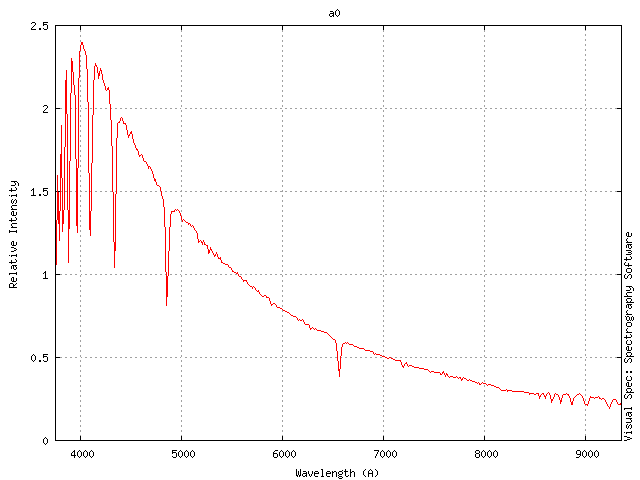
Perhaps not worded too cleverly on my part. The “oscillations” being the converging H lines. However using this method on meteors is not quite the same as using it on stars. For example when you divide a meteor spectrum through by a stellar spectrum there is still the issue of where exactly to select points to derive a continuum to act as the response.
I tended to end up with curves that were rather wavy. Below is an a quick plot I’ve made using an actual repsonse from an early test. Maybe its the methodology (as you describe in the examples on your web site) but for meteor spectrum correction I just don’t think it’s quite right.
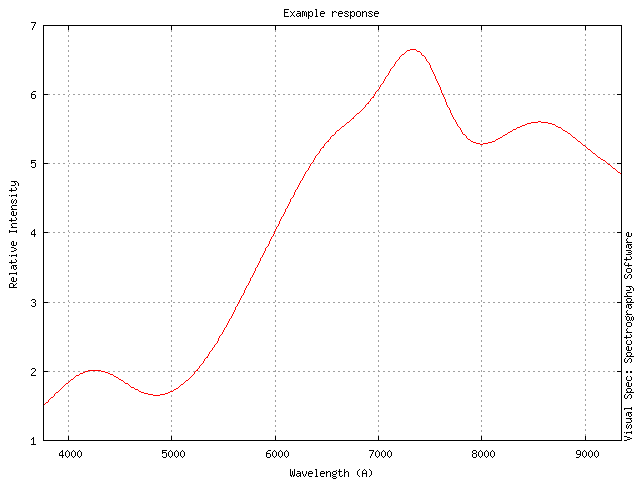
If one uses ones imagination it approximates the nominal silicon photodiode curve as it surely must. (Unless there is evidence that a silicon based detector was not used in the visible of course). Thats what put it into my mind to invesitgate further.
Here is a nominal silicon photodiode response curve I produced from date taken from a large photodiode manufacturers website.
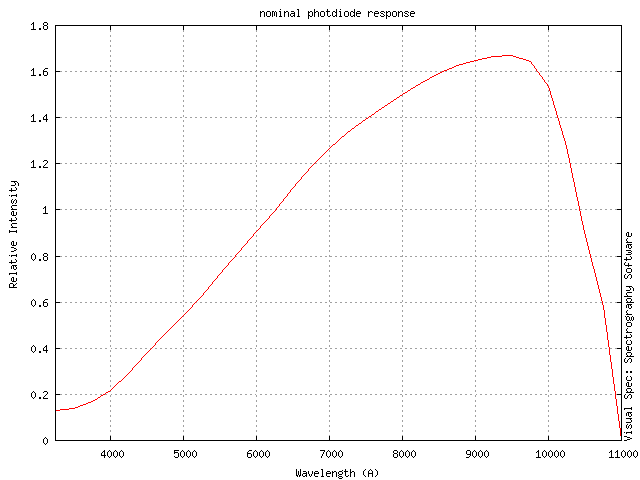
Dividing thorugh by this will give a form to the meteor spectrum then the other calibrations and corrections can be done as you discuss. However the problem with this approach is that although the form of the curve remains the same the peak moves slightly depending on how each photodiode site is biased by the electronics. THAT is a dark secret known only to the manufacturer!
From my experience at work I’d say the peak was closer to 820-850nm in real photodoides but I think that can be corrected itself by the appropriate normalisation point before division.
But then again maybe we’re right back to where we started…. It’s great fun!
There are a couple of papers by the various experts such as Borovicka and Jenniskens deriving absolute fluxes which is what we’d like. They seem to rely on various measurements made on the ratio of particular groups of lines (such iron lines in the blue) to derive an effective temperature. I’m not sure I understand the maths behind it but in some cases, but as promoted by Borovicka, there are different temperature regimes that complicate the matter further. These temperatures are generated by the particular properties of the meteoroid and its encounter with Earth, size, composition, velocity angle of entry etc. So getting what would be in effect an inverse black body curve for the appropriate physical temperature to do further calibration with is very difficult because we don’t know this in advance!
It is rather ironic that the very atmosphere that generates the meteor itself scatters efficiently in the blue. Right where the interesting lines are that we need to measure in the first place. Who’s say Pacha Mama doesn’t have a sense of humour….
I’m beginning to think “tricky” just doesn’t cover it ;-).
cheers,
Bill.
-
AuthorPosts
